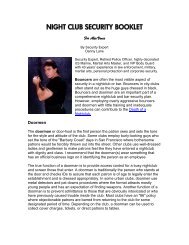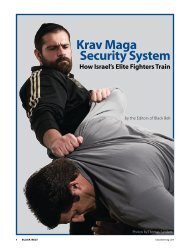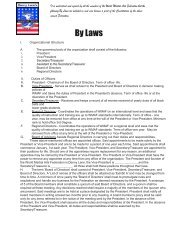2012_Summer_Chun Kuk Do Magazine - Danny Lane
2012_Summer_Chun Kuk Do Magazine - Danny Lane
2012_Summer_Chun Kuk Do Magazine - Danny Lane
You also want an ePaper? Increase the reach of your titles
YUMPU automatically turns print PDFs into web optimized ePapers that Google loves.
Drill of the issue:<br />
Fail<br />
improve<br />
so you can<br />
By Steve Brown<br />
5th degree black belt, Current CKD Men’s Heavyweight Fighting World Champion, 2011 UFAF Instructor of the Year<br />
s humans, we tend to learn the most through our failure. Of course, no one likes to fail, but beginners, in anything, experience some degree of failure, then learn and improve.<br />
A<br />
Many martial artists are guilty of reaching a plateau and settling in to what is comfortable, avoiding failure, both as students and instructors. Many of our training techniques<br />
are stagnant and never evolve beyond that of what we first learned, and so many are guilty of embracing that basic level of training as the end all and never realizing that was just<br />
one of the first steps in a long staircase.<br />
Let’s take a look at something we have all done … standing front kick with the rear leg on a body shield. Probably the first kick you ever learned. You came to class, you stood in<br />
your best fighting stance, the instructor guided you and adjusted the pad to be the perfect distance, and you concentrated on all the details you were taught to do the perfect thrust<br />
kick: load the leg with the knee high, thrust the kick forward, extend and release, pushing the ball of the foot into the target, recoil the leg with the knee high, set down with control,<br />
not falling forward, and repeat. Some of these kicks didn’t quite hit center. Some knocked you off balance. Some felt awkward. In other words, some were failures. You improved,<br />
auto-correcting every time, getting faster, stronger, learning from your failures as you tried to recreate the successful kicks.<br />
Now, you’re a green, red or even black belt. You get a partner and a pad, get in your best fighting stance, your partner squares off and gets ready and wham! You crush a front kick,<br />
again and again. After an impressive set of 10, you feel quite confident in the awesome power of your front kick and smirk as your partner tells you how you almost took the wind<br />
out of him through the pad. But wait … where was your failure? Where was the struggle to improve? You’ve taken a gold or purple belt pad drill to its limit; you’ve reached the<br />
plateau and it’s comfy there. It’s time to make you uncomfortable. Congratulations black belt; you’re a really good purple belt.<br />
So here’s the progression, or stages, you can go through in our pad drill example: static kicker/static pad holder; static kicker/dynamic pad holder; static kicker/dynamic pad holder<br />
(forcing failure about 30 percent of the time); dynamic kicker/dynamic pad holder; dynamic kicker/dynamic pad holder (forcing failure about 30 percent of the time).<br />
It goes like this:<br />
Static kicker/static pad holder - Beginner<br />
Regardless of rank, this is where you<br />
start with any new kick or skill when<br />
first learning it. Everything is controlled;<br />
both kicker and pad holder are stationary<br />
allowing the kicker to learn, adjust<br />
and improve the principles of the<br />
kick (posture, lines of power, methods<br />
of generating power, etc.) safely and<br />
consistently, building muscle memory<br />
and confidence. The “failure” factor is built<br />
in automatically through the beginner’s<br />
inexperience. Practice this way until you<br />
develop confidence with the kick, having<br />
consistency with technique and generating good power nine or 10 out of 10 times.<br />
Static kicker/dynamic pad holder – Beginner/Intermediate<br />
Apparently, the bullies and muggers of the world didn’t get the memo that they were supposed to stand still when we kick them. Now we<br />
introduce a new variable, the moving target. Our kicking is still done from the controlled static position, so we continue to develop our<br />
8 CKD <strong>Magazine</strong> | <strong>Summer</strong> <strong>2012</strong><br />
Past editions of CKD <strong>Magazine</strong> online http://ckdm.ufaf.org/<br />
technique, but now the element of external timing is introduced. The pad holder starts about six to eight feet away and moves at you at a steady<br />
rate. (This is for the front kick; different methods would be used for different kicks). Immediately, flaws in your technique are exposed as you have<br />
to deal with delivering the kick quicker and the fact that now there is mass moving at you that requires a more stable posture and effective release<br />
to stop the forward momentum.<br />
Static kicker/dynamic pad holder (forcing failure about 30 percent of the time) - Intermediate<br />
You’ve made your adjustments and learned how to time the kick; now the pad holder has to “go live.” It’s very important to have a good partner,<br />
as this person is your trainer, adjusting to your needs to help you learn. Regardless of your skill level with this drill, your partner will now charge at<br />
you with whatever speed or faking necessary to make you fail about 30 percent of the time, or three out of 10, resulting in getting you to execute<br />
the kick prematurely, or not get the kick off and they smash into you with the pad. (This always brings a smile to the pad holder’s face.)<br />
Dynamic kicker/dynamic pad holder – Intermediate/Advanced<br />
At this point your kick is pretty good; you will continue to get stronger and technically improve, but we need to add another variable, footwork.<br />
This stage incorporates whatever footwork you train with to keep your weapon (the front kick in this case) pointed at the target. (If it’s sport<br />
karate, you’re probably bouncing; if it’s self defense or MMA, you’re probably keeping a more grounded footwork.) Now, everything is moving.<br />
Your partner is moving more naturally around you, circling, angling and charging forward, and you are adjusting, keeping your kick ready to go.<br />
Through this stage, the pad holder should be letting you succeed to build confidence.<br />
Dynamic kicker/dynamic pad holder (forcing failure about 30 percent of the time) – Advanced<br />
Same as before with everything moving, but now your partner pulls out all of his or her tricks to fake, faint, blitz, angle, stutter-step and just plain<br />
run you over to get you to fail with the kick about three out of 10 times. To the most advanced students, this stage should be more than just a<br />
kicking drill. It should move beyond action/reaction to almost action/action where you are developing a sense of relaxation and calmness, learning<br />
to read the pad holder’s movement, just as in sparring, and develop an intuition that you no longer wait and react<br />
to his attack, but actually attack the attack.<br />
UFAF Shop online- http://www.ufaf.org/shop.htm<br />
CKD <strong>Magazine</strong> | Spring <strong>2012</strong> 9

















